 Go
to the Archive index
Go
to the Archive index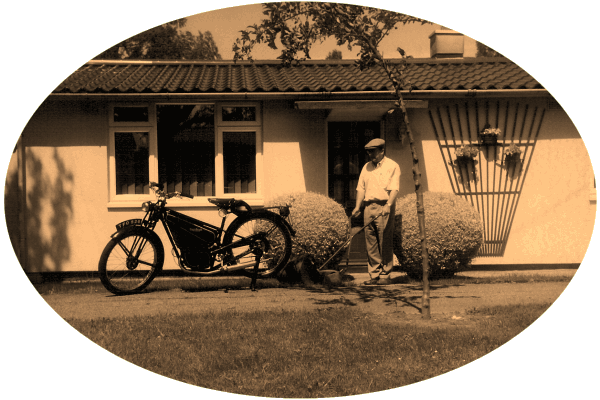
1950 time-warp: a pre-fab, Ransomes Ajax mower
and Francis-Barnett's new autocycle!
It's a cold but bright November morning. The year is 1938. We stand at the front of a line of hopefuls along a tall brick wall, beside a poster in a glass fronted notice case, "men wanted to build new autocycle, must have assembly experience". Wearing a brown flat cap, a watchman unlocks the wrought gate and ushers us across the factory yard to the foreman's office. He addresses us in a twanging Brummie accent, "As son of Graham Francis from Lea-Francis Motors, this company was registered in 1919 by Gordon Francis and Arthur Barnett, former Director at Singer and lately building cycles and motor cycles under the Invicta trademark. Gordon Francis is married to Arthur Barnett's daughter. Graham Francis backed the business and held a seat on the board. While Arthur Barnett died in 1936, his son Eric Barnett continues as managing director. You could say this is a family firm, welcome gentlemen to Francis-Barnett!"
Everyone now seems to be taking up George Herbert Jones design licence to build fashionable new Villiers engined autocycles. Raynal had been first in 1937, closely followed by Excelsior, Coventry Eagle and James during the following year. Now with a feature appearing in Motor Cycling on 9th November 1938, Francis-Barnett seems set to follow suit.
The J50 Powerbike luxury autocycle for the 1939 season features a novel rubber compression front suspension system, petrol tank and full engine shielding attractively finished in silver with blue coachline, and a flat toolbox at the front of the rack (that would shortly evolve to a round toolbox located in the rear loop of the carrier). Developments for the 1940 K50 Powerbike introduced a Junior De Luxe motor, replacing the earlier Villiers Junior, however production was seriously interrupted when the factory became remodelled to the horizontal style by Hermann Goering's Luftwaffe in the first bombing of Coventry on 14th November. Next door, the Triumph motor cycle plant was also flattened, so that's the end of our job building autocycles and it's off to the army for us for the rest of the duration!
Quickly returning to production after the unpleasantness with Mr Hitler had been resolved, the Powerbike was back on sale again with its JDL motor in 1946. The following year and another bombshell dropped: in June 1947 it was announced that Francis-Barnett had been taken over by AMC! Associated Motor Cycles was the name adopted in 1938 by the parent company originated from Matchless, who had taken over AJS in 1931, and bought Sunbeam from ICI in 1936. Further change was coming late in 1948, as Villiers informed its customers of the JDL engine that it was to become succeeded by a new autocycle motor. To be introduced from 1949, a wholly revised installation would be required to mount the latest engine. Francis-Barnett were quick to seize the opportunity, and among the first manufacturers to complete their new 2F autocycle - and it's a jolly smart example of this very model that's been delivered in the back garden for today's feature.
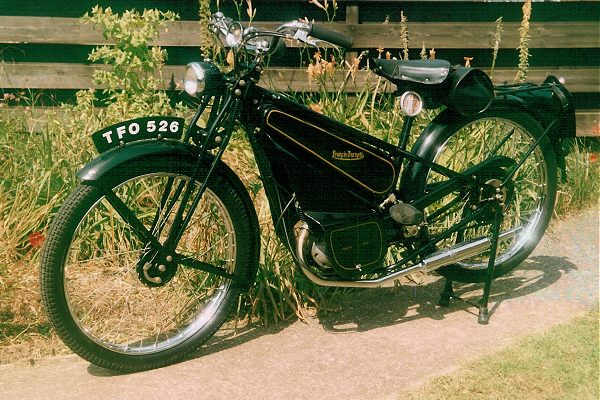
Showing how the top tube splits at the seat stem upright
The styling still looks quite like the earlier generation machines, so perhaps they thought the old ways were the best! Everything about the look of the Powerbike 56 appears very staid and traditional, but where it really shines is in the quality of its engineering. Despite maintaining its old-fashioned look, the new cradle frame is quite revolutionary in its jig-welded assembly, where most contemporaries were still being built with brazed lug construction. Just examine the detail to appreciate what a tidy and practical design it really is. The top tube neatly splits into the rear stays at the stem upright, while still maintaining the same triangulation line from the headstock - nicely thought out, neatly executed, and so very correct!
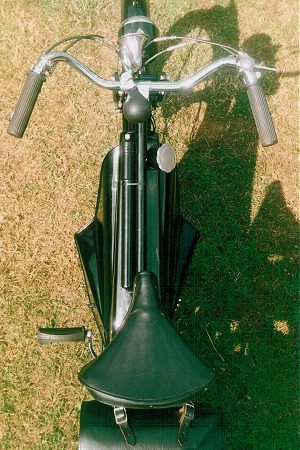
Top view showing the 'air scoop' engine covers
The back pedal braking arrangement is carried over from the original Powerbike model, not a particularly common practice on autocycles, but it does de-clutter the left handlebar, which would otherwise carry two control levers. The early rubber compression block forks have thankfully been succeeded by rubber band suspended girders, so at least that resolved the slightly distracting effect of the wheelbase changing when the springing and front brake used to operate! The sidepanels effectively box in the engine, easy, clean,out of sight (and out of mind?) The elegant pre-war silver with blue lining combination became replaced by the classic if rather unimaginative black with gold lining formula, with chrome plated wheel rims as standard.
Nudge the bike forward and down off the traditional rear stand, then snap it up in its clip at the back of the rear mudguard - no technological advances here! Now back the bike down the path toward the gate and... hello? It's stopped dead! What's going on here? The clutch lever is still clipped back? Oh, hold on - some of these pedal brake autocycles had a reversing latch. Ah, here we are on the front of the rod linkage, push the tag to unlock the latch. Not so easy when you've already backed on the brake, but once you know about the need to trip the reversing latch, it shouldn't catch you out too often. When the pedals are rotated forward again, the latch automatically resets for braking operation.
Sitting on the bike and looking down, you only then appreciate how much those engine panels billow out at the front like great conical air-scoops. The pullback handlebars hark to the echoes of a bygone age, but their form suits the style of the machine, and they feel comfortable enough for low performance applications.
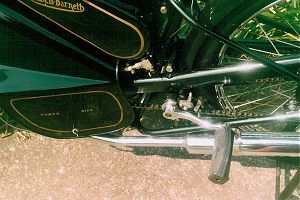
Showing the fuel tap
The petrol tap turns on at back left of the tank then, surprisingly, there's no port in the left sidepanel to even access the carb flood button, though the motor doesn't seem to need it as the engine fires up readily on the choke alone, which operates by a knob in the right hand engine panel. Fine in summer, but one wonders how it fares on a cold winters morning. The side-blow exhaust delivers a pleasant muted note, latch off the clutch, tweak up the throttle lever, and nudge on the pedals for a conventional autocycle-style assisted take-off. The frame geometry feels confidently stable, and the bike very much chooses to steam a straight course ahead. The 'rubber band' front forks look busy doing their job on the road bumps, giving a well-planted feel to the general ride, though you will of course become aware of the hard tail once the tarmac surface deteriorates. Despite sounding unpleasantly 'mechanical' in operation, the back pedal brake is particularly effective, and the front brake works pretty well too, so stopping ability is well up to the performance.
Comfortable cruising speed is about 25mph, above which, vibrations are increasingly felt through the handlebars if you're not wearing gloves. With gloves, these effects become barely noticeable, and the ride feels pleasantly smooth. Our pace bike recorded best speed on the flat as 34mph (rider crouched, light tailwind), and 38mph downhill, though this 53 year old Villiers 2F motor did feel like it could now be slipping slightly past its prime, and not quite delivering the best of its breed.
The wide flare to the engine covers does contact your feet at the front of the pedal arc, which you tend to compensate for by turning your toes out. Perhaps Powerbike 56 riders adapt and cease to notice after a while, though you may still be able to spot them by their evolved Daffy Duck walk! I never did get used to the rear brake reversing latch; you only remember the darn thing when the bike stops dead, and cursing at it doesn't help to unlock it any better!
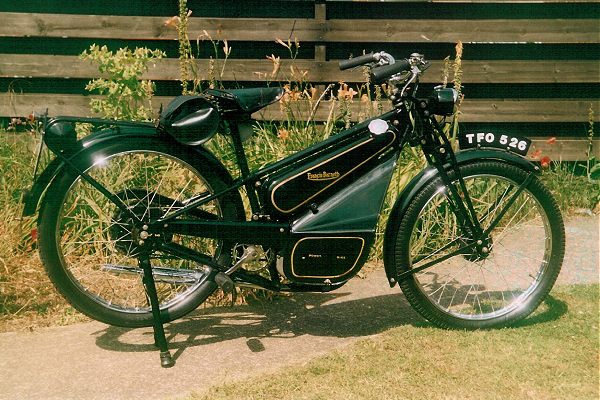
Offside view: note the choke control lever protruding from the engine
cover
Francis-Barnett only sold the Powerbike 56 for three years, so it's not a machine you commonly come across. Great expectations for the new 2F autocycle were sadly disappointed as sales became badly hit by the move toward cheap cyclemotor attachments. Sun had been the first to read the writing on the wall for the autocycle, withdrawing their 2F version in 1950 after barely two years production. The Associated Motor Cycle Group was all about increasing numbers, not falling ones, and accountants drew a line under the last Francis-Barnett autocycle at the end of the 1951 season. While the Sunbeam brand had been sold on to the BSA group following WWII, Associated Motor Cycles went on to take over James in 1951, then Norton in 1956. For a brief period AMC Group became the biggest motor cycle manufacturer in the world, but fortunes waned,and on the 4th of August 1966, the giant fell, taking Francis-Barnett with it into the dark abyss.
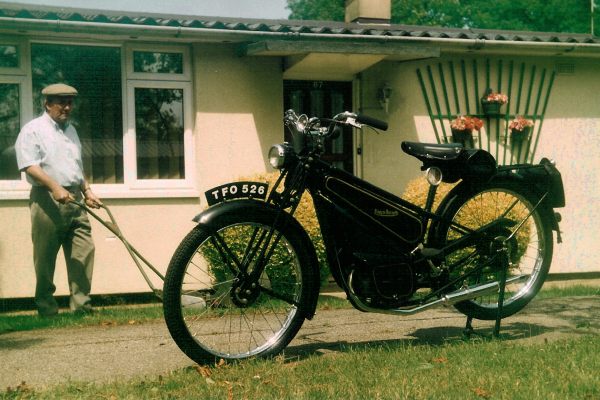
A last look at the Powerbike parked outside the pre-fab
Next Issue: De-listing of the Powerbike Model 56 in 1951 left just one autocycle in the AMC group. We track the Long Riders down to the 'Hole in the Wall' for the final showdown.
First published, August 2004